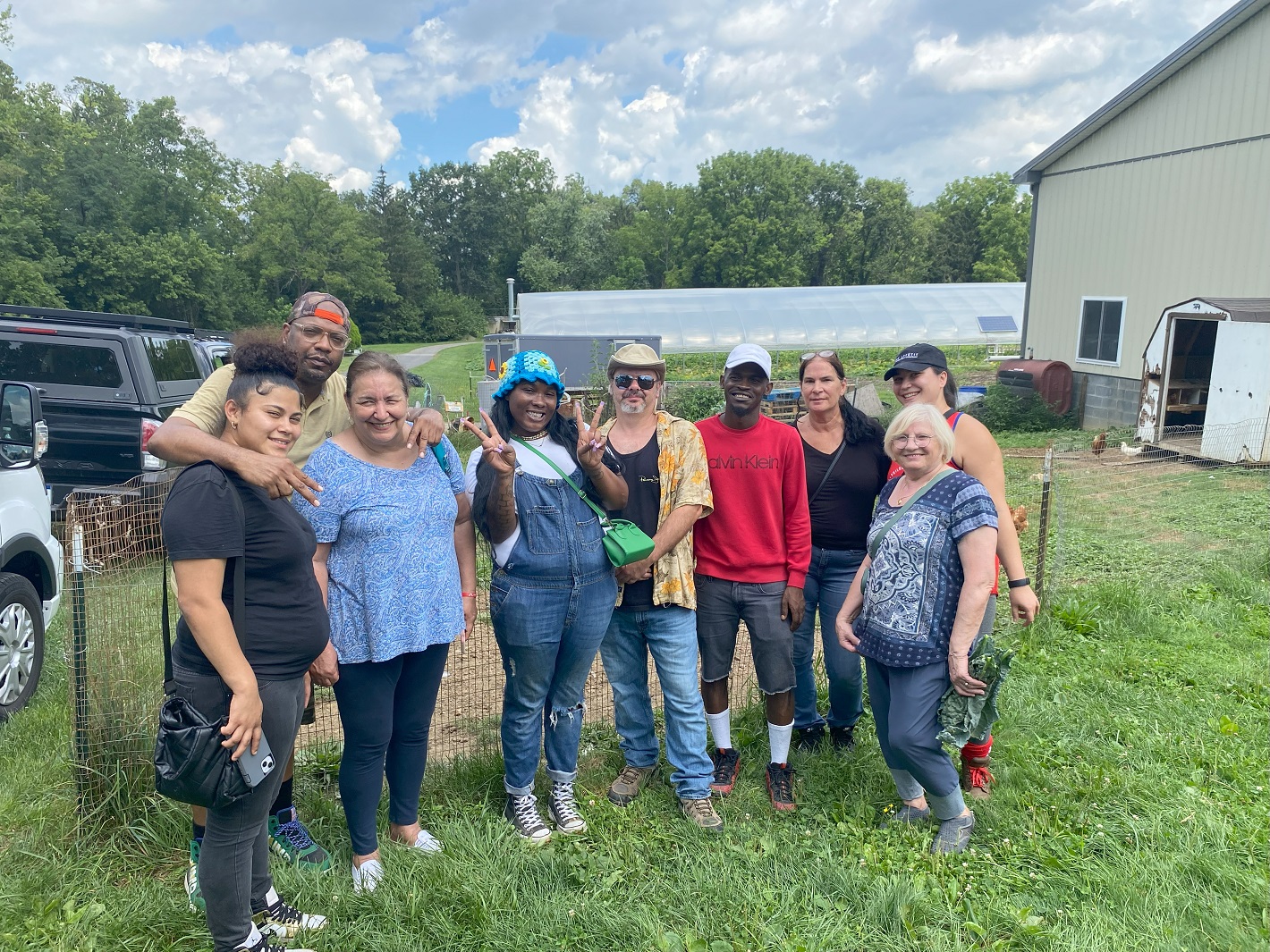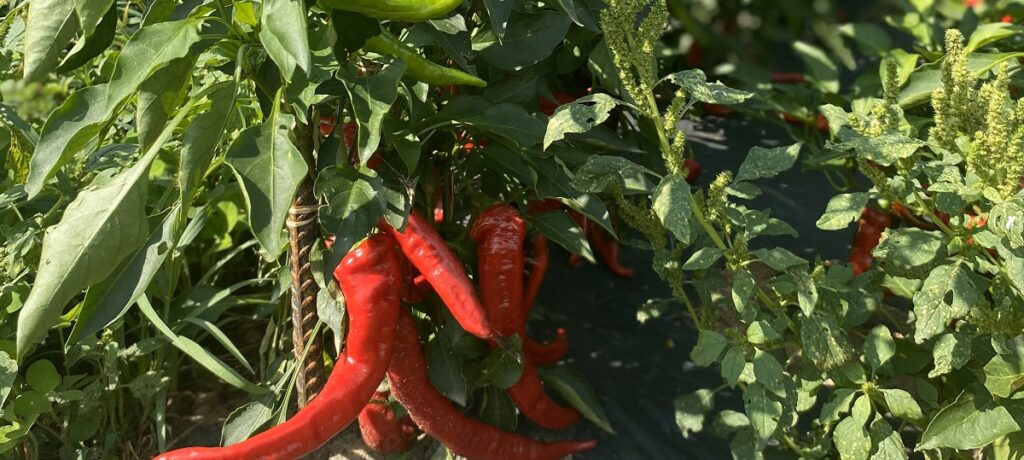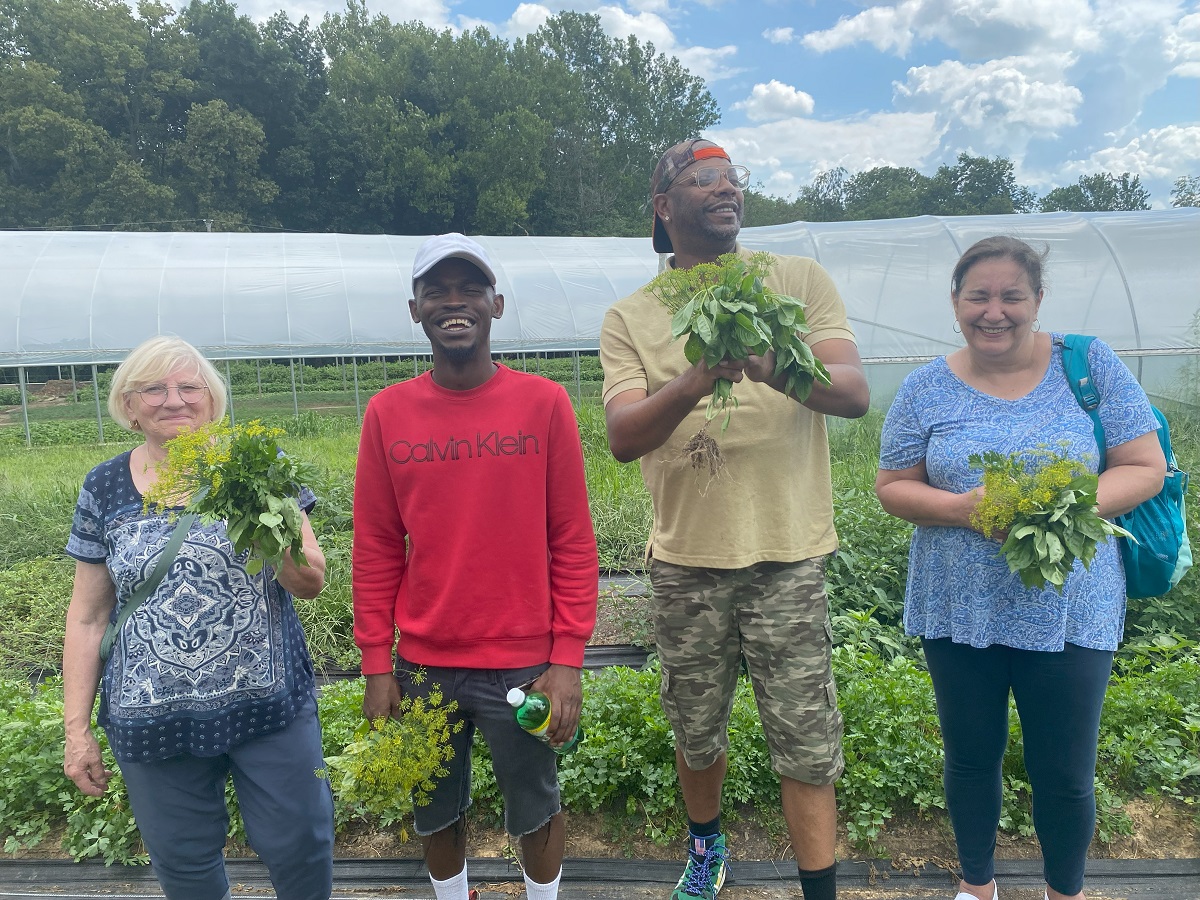Agriculture Up Close: Curtis Institute of Music Connects with Lancaster County Farms
- by bonappetit

The Curtis team, left to right: Jaz Muniz, food service worker; Warren Griffin, cook; Diana Ciarlante, cashier; Bianca Daniels, cashier/food service worker; Tom Dicicco, executive chef; Antoine Cook, cook; Tracy Coleman, -front of house and catering supervisor; Natalie Armentrout, director of dining; Stella Muncan, food service worker.
A farmer and member of the Lancaster Farm Fresh Cooperative (LFFC) points out the crop of squash blossoms he’s cultivating on his farm. Some buds are tightly closed; others beginning to open, and that evening when the air cools down, he and his team will head out to the fields and harvest those blossoms by hand, sometimes working until 2:00am to fill a larger order. Any blooms that are too far open to harvest for this specialty crop get left on the vine to grow into squash, he explains.
He’s talking to the Bon Appétit culinary team from the Curtis Institute of Music in Philadelphia, PA, close to Lancaster County but a world away in many respects. Director of Dining Natalie Armentrout has brought her team out at the start of the fall semester to tour three of the LFFC farms in the café’s sourcing network. For many of the team members, says Natalie, it was the first time visiting a farm. “I knew it was something that was going to change their perspective,” she mused.
Scaling Local Agriculture in Lancaster County
The Bon Appétit team met up with the LFFC founder and sales rep at LFFC headquarters, 90 minutes from downtown Philly at the edge of Lancaster County. The large warehouse is home to the co-operative, which currently has over 100 organic farms and was founded in 2006 to enhance farmers’ livelihoods and ways of life in an industry that was becoming ever more dominated by agribusiness. As a co-operative, the farmers are the owners of LFFC. They make the decisions collectively, working closely with the staff to sustain the co-op’s success.
For Natalie, visiting the farms was a way to create experiential learning for her team at the start of the school year, but also to inspire them by showing them what’s growing in their own foodshed – and get them thinking about how they can incorporate more of those ingredients into regular use in Curtis’s cafés. Not only does this translate into fresher and tastier food for students, but it can solidify Curtis as a supporter of local agriculture.
“We started partnering with LFFC for a weekly produce market during the last school year,” says Natalie. The market came out of a desire to present students with different options for using their dining dollars beyond the prepared food stations. Whatever wasn’t purchased would be incorporated by chefs into the daily menus.
Natalie hoped it would also spark engagement with students and staff, increasing demand for more of the local ingredients in daily menus. Sometimes she’d buy an eye-catching item, like indigo blue tomatoes or white eggplant, which would capture people’s attention. Not only did it get people to stop and make conversation, but “it was a way for us to speak to our brand,” she says, “at a time when we were very new at this account.”
Venturing into the Field
The first stop of the day was an Amish-owned produce farm featuring a diverse range of unusual vegetable and fruit varieties. Yellow watermelons, Indigo rose tomatoes, peppers of all types. As the team walked the fields, the farmer pointed out some of the different pepper crops: long red hot peppers, Sugar Rush peach peppers, lots of little sweet types – the Bon Appétit crew realized that they’d used these peppers to make a hot honey used in their Eat Local Challenge meal last year. It was the kind of lightbulb moment Natalie had been hoping for.

Red hot peppers on the vine
At the second farm, two draft horses pulling a cart full of watermelons trotted up just as the team was arriving. Like the first, biodiversity was on display with different types of watermelon that you’d never find in a grocery store or on a standard order sheet – melons with names like Moon and Stars, with its speckled rind and deep pink flesh; and yellow-hued Baby Doll. While walking through the rows of herbs, the farmer offered tastes of dill blossoms – he was trying to see if there was a market for the blooms. “They were totally delicious,” says Natalie. “They tasted very bright, almost bitter, almost like yuzu with a hint of dill.”
The team was having the time of their lives. When they reached the third stop of the day, they were greeted by an abundance of livestock. They pulled in right in front of a huge barn with chickens roaming in and around it. Behind the barn was a field of horses, with pigs and goats dotting the landscape too. A tour of the produce rows ensued, along with a description of how the greenhouses are used to germinate seedlings in the spring for summer crops and in the summer for fall crops. As Natalie walked along the rows of kale, she noticed that members of the team had disappeared. When she found them, they were off taking pictures of the pigs.
“Part of bringing everybody out here,” Natalie said, was about wanting staff to have that deeper appreciation. “I want [our team] to understand how much work goes into the food that goes onto Curtis plates. We’re so far removed from how and where any of our food comes from,” she said. “And if you don’t physically go [to the farms], it’s harder to make that connection in your head.”

Stella Muncan, Antoine Cook, Warren Griffin, and Diana Ciarliante with their basil and dill bouquets.